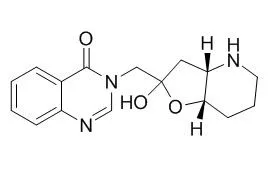| In vivo: |
| Phytother Res. 2003 Dec;17(10):1234-6. | | Combination effects of chloroquine with the febrifugine and isofebrifugine mixture against a blood-induced infection with chloroquine-resistant Plasmodium berghei NK65 in ICR mice.[Pubmed: 14669265] | The combination effects of chloroquine with a mixture of febrifugine and Isofebrifugine were evaluated against a blood-induced infection with chloroquine-resistant P. berghei NK65 in ICR mice.
METHODS AND RESULTS:
Mice in the untreated control showed a progressively increasing parasitemia leading to mouse death. A two-day dosage of 20 mg base/kg of chloroquine alone showed little effect against P. berghei NK65 infection, and all mice died from day 13 to 14 with an increasing parasitemia. A four-day dosage of 1 mg/kg of the febrifugine and Isofebrifugine mixture alone showed a little antimalarial activity, but all mice died from day 19 to 27 with an increasing parasitemia. On the other hand, mice treated with chloroquine plus alkaloids survived during the experiment. All mice treated with chloroquine alone or the alkaloid mixture alone showed low parasitemia levels during a drug administration and following a few days, but then malaria parasites increased in the bloodstream of the treated mice until death. On the other hand, malaria parasites in the mice given chloroquine plus alkaloids decreased on day 6 and then were not detected by a microscopic examination during observation period. | | Journal of Natural Medicines, 2007 , 61 (2) :213-216. | | Seasonal variation in the content of a febrifugine and isofebrifugine alkaloid mixture in aerial parts of Hydrangea macrophylla var. Otaksa, with special reference to its antimalarial activity[Reference: WebLink] | Febrifugine and Isofebrifugine alkaloid mixtures extracted from the leaves and buds of Hydrangea macrophylla var. Otaksa , collected during different months, in Japan, were quantified using high-performance liquid chromatography.
METHODS AND RESULTS:
Leaves collected during the flowering season, namely from June to August, contained 0.16–0.3102mg/g of the alkaloid mixture, whereas those collected from September to December had less than 0.0302mg/g of the mixture. However, extracts of buds harvested from October to February contained a consistently larger amount (more than 0.4902mg/g) of the alkaloids. Hot-water extracts from the leaves and buds collected during different seasons were evaluated for antimalarial activity against Plasmodium yoelii 17XL in mice. The extract of leaves collected in August demonstrated high antimalarial activity, and all mice that received the extract survived the infection. In contrast, the extract of leaves collected in December showed little activity. The extract of buds collected in December cleared parasites, but with subsequent mortality to mouse.
CONCLUSIONS:
The present results show that the amount of antimalarial agent—febrifugine and Isofebrifugine mixture—in H. macrophylla var. Otaksa is both part- and season-dependent, suggesting that the choice of plant parts and their harvesting season are important factors worth considering in the pharmacological use of medicinal plants. |
|






 Cell. 2018 Jan 11;172(1-2):249-261.e12. doi: 10.1016/j.cell.2017.12.019.IF=36.216(2019)
Cell. 2018 Jan 11;172(1-2):249-261.e12. doi: 10.1016/j.cell.2017.12.019.IF=36.216(2019) Cell Metab. 2020 Mar 3;31(3):534-548.e5. doi: 10.1016/j.cmet.2020.01.002.IF=22.415(2019)
Cell Metab. 2020 Mar 3;31(3):534-548.e5. doi: 10.1016/j.cmet.2020.01.002.IF=22.415(2019) Mol Cell. 2017 Nov 16;68(4):673-685.e6. doi: 10.1016/j.molcel.2017.10.022.IF=14.548(2019)
Mol Cell. 2017 Nov 16;68(4):673-685.e6. doi: 10.1016/j.molcel.2017.10.022.IF=14.548(2019)